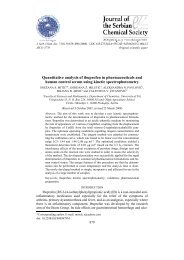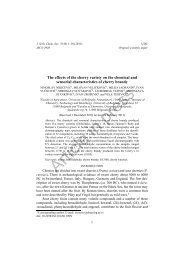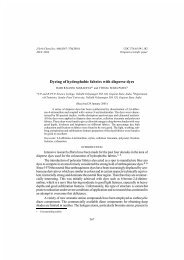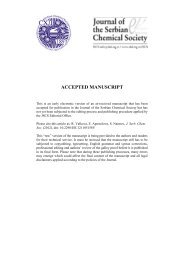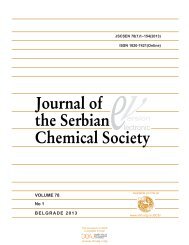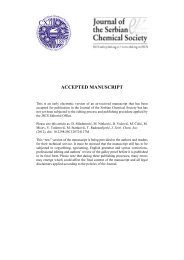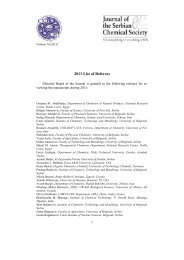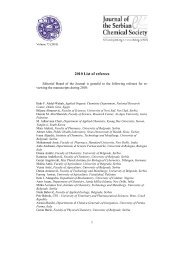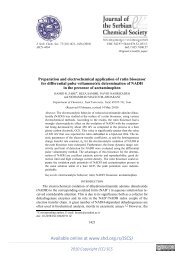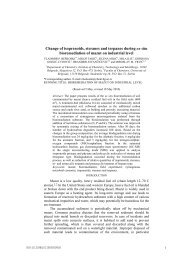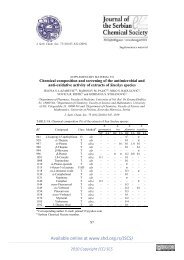ACCEPTED MANUSCRIPT
ACCEPTED MANUSCRIPT
ACCEPTED MANUSCRIPT
Create successful ePaper yourself
Turn your PDF publications into a flip-book with our unique Google optimized e-Paper software.
<strong>ACCEPTED</strong> <strong>MANUSCRIPT</strong><br />
This is an early electronic version of an as-received manuscript that has been<br />
accepted for publication in the Journal of the Serbian Chemical Society but has<br />
not yet been subjected to the editing process and publishing procedure applied by<br />
the JSCS Editorial Office.<br />
Please cite this article as: D. Poleti, Lj. Karanović, M. Zdujić, Č. Jovalekić,<br />
J. Serb. Chem. Soc. (2011), doi: 10.2298/JSC110914215P<br />
This “raw” version of the manuscript is being provided to the authors and<br />
readers for their technical service. It must be stressed that the manuscript still has<br />
to be subjected to copyediting, typesetting, English grammar and syntax<br />
corrections, professional editing and authors’ review of the galley proof before it<br />
is published in its final form. Please note that during these publishing processes,<br />
many errors may emerge which could affect the final content of the manuscript<br />
and all legal disclaimers applied according to the policies of the Journal.
J. Serb. Chem. Soc. 76 (0) 1–12 (2011) UDC<br />
JSCS–5206 Note<br />
NOTE<br />
Phase composition of Bi2O3 specimens doped with Ti, Zr and Hf<br />
DEJAN POLETI1* # , LJILJANA KARANOVIĆ2 , MIODRAG ZDUJIĆ3# and ČEDOMIR JOVALEKIĆ4 1 Department of General and Inorganic Chemistry, Faculty of Technology and Metallurgy,<br />
University of Belgrade, Karnegijeva 4, 11000 Belgrade, 2 Laboratory of Crystallography,<br />
Faculty of Mining and Geology, University of Belgrade, Đušina 7, 11000 Belgrade<br />
3 Institute of Technical Sciences of the Serbian Academy of Science and Arts, Knez<br />
Mihailova 35, 11000 Belgrade and 4 Institute for Multidisciplinary Research,<br />
Kneza Višeslava 1a, 11000 Belgrade, Serbia<br />
(Received 14 September, revised 17 December 2011)<br />
Abstract: Powder mixtures of α-Bi2O3 containing 2, 5 and 10 mole % of TiO2, ZrO2 or HfO2 were homogenized, heated at 820 ºC for 24 h and quenched in<br />
air. X-ray powder diffraction technique was used to characterize the prepared<br />
samples. In all cases metastable Bi2O3 polymorphs, γ-Bi2O3 or β-Bi2O3, are<br />
found as single or major phases. Addition of Ti 4+ ions stabilizes γ-Bi2O3 polymorph, while either Zr 4+ or Hf 4+ ions stabilize β-Bi2O3 polymorph. In the<br />
samples with 2 and 5 mole % of TiO2 the presence of even two γ-Bi2O3 phases<br />
(Bi12TiO20 compound and a very low Ti-doped γ-Bi2O3) was established.<br />
Similarly, in the sample with 2 mole % of HfO2 two β-Bi2O3 phases were<br />
found. Phase composition of prepared samples, values of unit cell parameters<br />
and the appearance of two polymorphs with identical crystal structure but<br />
different unit cell parameters are discussed and compared with known data.<br />
Keywords: bismuth(III) oxide; dopants; 4 th group elements; X-ray powder<br />
diffraction; phase composition; unit cell parameters.<br />
Accepted Manuscript<br />
INTRODUCTION<br />
Due to great diversity of polymorphic modifications and many useful<br />
physical properties, pure or doped bismuth(III) oxide, Bi2O3, is permanently in<br />
focus of scientific interest. In addition to four well-known polymorphs: α-, β-, γ-<br />
and δ-Bi2O3, 1-4 three new Bi2O3 polymorphs were described recently. 5.6 There is<br />
general agreement that only α-Bi2O3 form is stable at room temperature. 2,7,8<br />
* Corresponding author. E-mail: dejan@tmf.bg.ac.rs<br />
# Serbian Chemical Society member.<br />
doi: 10.2298/JSC110914215P<br />
1
2 POLETI et al.<br />
However, various metastable or high-temperature polymorphs, like β-, γ- and δ-<br />
Bi2O3, can readily be stabilized by addition of proper dopants, which can be<br />
cations of any charge, usually added as corresponding oxides. 4,6,7,9-11 Some<br />
bismuth(III) oxides of this kind, as γ-Bi2O3, have valuable optical<br />
(photorefractive, photoluminescent, photoconductive) properties, 12 some other, as<br />
β- and δ-Bi2O3, belong to the group of high oxide ion conductors. 13,14<br />
Although Bi2O3–TiO2 system should be considered as well-characterized,<br />
since detailed phase diagrams are known, 15 in our previous study 9 quite unusual<br />
coexistence of two Ti-doped γ-Bi2O3 phases was observed in the Bi2O3-rich<br />
region. At the same time, Bi2O3–MO2 systems, where M = Zr or Hf, are not so<br />
well-known and data are often contradictory, both for Bi2O3-rich 7,10,11,16 and<br />
MO2-rich 17,18 region. For these reasons, in this paper a systematic<br />
crystallographic study of Bi2O3 samples low-doped (2, 5 and 10 mole %) with Ti,<br />
Zr and Hf as 4 th group elements is described.<br />
EXPERIMENTAL<br />
Four commercial powders: Bi2O 3 (> 99 % purity), TiO 2 (99.8 %), ZrO 2 (> 99 %) and<br />
HfO 2 (> 98.5 %) were used in this study. By means of X-ray powder diffraction technique<br />
(XRPD), Bi2O 3 and TiO 2 were identified as being in the α-Bi 2O 3 (bismite) and rutile form,<br />
respectively; ZrO2 was mostly present as baddeleyite modification, but contained about 5<br />
mass % of the high-temperature tetragonal polymorph (JCPDS Card No. 42-1164), whereas<br />
HfO 2 was in the monoclinic, analogous to baddeleyite, modification (JCPDS Card No. 34-<br />
0104) with about 1.5 mass % of ZrO2 as impurity.<br />
Powder mixtures of α-Bi 2O 3 containing 2, 5 and 10 mole % of TiO 2, ZrO 2 or HfO 2 were<br />
dry homogenized in an agate mortar, pressed in tablets (∅ = 8 mm, h ≈ 1.5 mm) under 50<br />
MPa, calcined in Pt-crucibles at 820 ºC for 24 h and air-quenched to room temperature.<br />
After reground, XRPD data of the prepared samples were collected on a Philips PW1710<br />
diffractometer equipped with a graphite monochromator (Cu-Kα radiation, λ = 1.5418 Å) in<br />
the range 10 − 90 º2θ (step-length: 0.02 º2θ, scan time: 1 s). The program PowderCell 19 was<br />
used for a semiquantitative phase analysis. Unit cell parameters were calculated by the leastsquares<br />
method using the program LSUCRIPC. 20<br />
RESULTS AND DISCUSSION<br />
The results are summarized in Table I and can be commented as follows.<br />
Bi2O3–TiO2 system. The definite composition of the body-centered cubic γ-<br />
Bi2O3 phase in this system is Bi12TiO20 (14.3 mole % TiO2), 3 which was<br />
confirmed several times by the crystal structure determination. 9 and references therein As<br />
briefly mentioned in Introduction, if quantity of TiO2 is reduced to 7.7 mole %, a<br />
mixture of two phases both with γ-Bi2O3 structure was obtained previously. 9 The<br />
same feature was observed in this study (Fig. S-1), but the results show that the<br />
actual range of two-phase region extends toward very low TiO2 content. Thus, a<br />
quantity of only 2 mole % (0.35 mass %) was sufficient to obtain mixed-phase<br />
specimens. One unit cell parameter (aTi, Table I) is in agreement with the<br />
literature data for unit cell parameter of Bi12TiO20 phase (a ≈ 10.18 – 10.19 Å),<br />
Accepted Manuscript
Bi 2O 3 SPECIMENS DOPED WITH Ti, Zr AND Hf 3<br />
while another (ass, Table I) corresponds to the unit cell parameter of undoped γ-<br />
Bi2O3 (a ≈ 10.26 Å). 9 As expected, with increasing Ti-content the amount of<br />
Bi12TiO20 phase increases, showing the significance of the initial mixture<br />
stoichiometry. The coexistence of two phases with γ-Bi2O3 structure was also<br />
noticed and discussed by Guha et al. 21 in the Bi2O3-rich region of the Bi2O3–<br />
ZnO2 system. After a comprehensive research they concluded that one phase is<br />
Bi38ZnO58 (equivalent to Bi12TiO20), whereas the second phase was described as<br />
γ-Bi2O3 solid solution with no more than 2.2 mole % of ZnO. Very likely,<br />
analogous solid solution exists in the Bi2O3–TiO2 system, although this was not<br />
predicted in the phase diagram. Preliminary results of EDS analysis also revealed<br />
traces of Ti in our γ-Bi2O3 solid solution.<br />
The appearance of Bi4Ti3O12 in the sample with 10 mole % of TiO2 is also<br />
surprising because under similar conditions Bi8TiO14, but not Bi4Ti3O12, may<br />
arise according to the phase diagram. 15<br />
Bi2O3–ZrO2 system. As seen from Table I and Fig. S-2, in the Bi2O3–ZrO2<br />
system containing ≤ 10 mole % of ZrO2 single-phase β-Bi2O3 specimens, which<br />
can be described as solid solutions with general formula Bi2–xZrxO3+x/2, were<br />
obtained in all cases. Therefore, stabilization by Zr 4+ ions is the simplest way to<br />
obtain a tetragonal β-Bi2O3 phase at room temperature. While the values of c-axis<br />
are nearly constant (Table I), a-axes and unit cell volumes pass through<br />
minimum at x about 0.05. When compared with unit cell volume of undoped β-<br />
Bi2O3, 22 unit cell volumes of Zr-doped β-Bi2O3 are smaller due to smaller radius<br />
of Zr 4+ in respect to Bi 3+ ions. 23 This also confirms the presence of Zr 4+ ions in<br />
the prepared solid solutions. These results are in general agreement with data<br />
published by Abrahams and co-workers, 10 but their samples with x < 0.05 were<br />
not single-phase and contained α-Bi2O3 as a secondary phase. A plausible<br />
explanation for such discrepancy could be different heat treatments applied.<br />
Bi2O3–HfO2 system. Apparently, Hf 4+ ions also tend to stabilize β-Bi2O3,<br />
since this phase predominates in all samples (Table I, Fig. S-3). With one<br />
exception, unit cells of Bi2–xHfxO3+x/2 are larger than unit cells of the<br />
corresponding Bi2–xZrxO3+x/2 solid solutions and undoped β-Bi2O3, implying a<br />
bigger effective ionic radius of Hf 4+ in Bi2O3 host lattice. In comparison to<br />
Accepted Manuscript<br />
Bi2O3–ZrO2 system, the main difference is that single-phase samples were not<br />
attained, while in samples with higher Hf-content cubic δ-Bi2O3 appeared as a<br />
minor phase. In fact, trace amounts of HfO2 were also observed in the sample<br />
doped with 10 mole % of HfO2 suggesting that thermodynamic equilibrium was<br />
not achieved. However, due to long annealing time applied, this should be related<br />
to the upper limits of solubility of Zr 4+ and Hf 4+ ions in corresponding solid<br />
solutions with β-Bi2O3 structure. According to Sorokina and Sleight, the<br />
solubility of Hf 4+ is smaller than solubility Zr 4+ ions and the limiting formulae are<br />
Bi1.84Zr0.16O3.08 and Bi1.94Hf0.06O3.03. 11 Similarly, Ayala and López-Garcia 17 found
4 POLETI et al.<br />
that the maximum concentration of Hf 4+ ions in Bi2–xHfxO3+x/2 solid solution is<br />
only about 5 mole %. An increased tendency of Hf 4+ ions to stabilize cubic δ-<br />
Bi2O3 phase, as described in our previous papers, 24,25 could also have some<br />
influence. The unit cell parameter of δ-phase in the sample doped with 10 mole<br />
% of HfO2 is higher than the values reported (5.266 – 5.459 Å) for corresponding<br />
δ-phases containing Hf 4+ ions, 11 but lower than values (5.655 − 5.665 Å) for<br />
undoped δ-Bi2O3. 2,26<br />
The most interesting result of this study is the appearance of two β-Bi2O3<br />
phases in the sample with 2 mole % of HfO2. To our best knowledge, this has<br />
never been reported, and shows that there are some analogies between γ- and β-<br />
Bi2O3, i.e. the coexistence of two crystallographicaly identical phases with<br />
different unit cell parameters in very low-doped samples can be expected. Unit<br />
cell parameters of major, β1-Bi2O3 phase (Table I) are close to the literature<br />
values (JCPDS Card No. 43-0207 and ref. 17), but obtained very high unit cell<br />
parameters of minor β2-Bi2O3 phase is difficult to explain. The proper<br />
rationalization of this system requires additional studies and will be issue of our<br />
future work.<br />
In conclusion, described differences between Bi2O3 samples doped with Ti<br />
and doped with Zr- or Hf can be judged as expected. However, somewhat distinct<br />
behavior of Zr- and Hf-doped samples could be understood as fairly surprising,<br />
bearing in mind close chemical similarity and identical metal and ionic radii of<br />
the elements. Nevertheless, similar discrepancies were observed previously<br />
during the investigation of Bi2O3–MO2 systems, M = Zr, Hf, 11 and our studies of<br />
mechanochemically treated 2Bi2O3·3ZrO2 26 and 2Bi2O3·3HfO2 27 mixtures.<br />
SUPPLEMENTARY MATERIAL<br />
Figs. 1-S, 2-S and 3-S showing experimental X-ray powder diffraction patterns are<br />
available electronically at http:/www.shd.org.rs/JSCS/, or from the corresponding author on<br />
request.<br />
Acknowledgements. This study was financially supported by the Ministry of Education<br />
and Science of the Republic of Serbia (Grant Nos. 45007, 45001 and 45015), which is<br />
gratefully acknowledged.<br />
Accepted Manuscript<br />
ИЗВОД<br />
ФАЗНИ САСТАВ УЗОРАКА Bi2О3 ДОПИРАНИХ СА Ti, Zr И Hf<br />
ДЕЈАН ПОЛЕТИ 1 , ЉИЉАНА КАРАНОВИЋ 2 , МИОДРАГ ЗДУЈИЋ 3 и ЧЕДОМИР ЈОВАЛЕКИЋ 4<br />
1Katedra za op{tu i neorgansku hemiju, Tehnolo{ko–metalur{ki fakultet,Univerzitet u Beogradu,<br />
Karnegijeva 4, 11000 Beograd, 2Laboratorija za kristalografiju, Rudarsko–geolo{ki fakultet,<br />
Univerzitet u Beogradu, \u{ina 7, 11000 Beograd, 3Institut tehni~kih nauka SANU, Knez<br />
Mihailova 35, 11000 Beograd i 4Institut za multidisciplinarna istra`ivawa,<br />
Univerzitet u Beogradu, Kneza Vi{eslava 1a, 11000 Beograd<br />
Хомогенизоване смеше прахова α-Bi2O3 са 2, 5 и 10 mol. % TiO2, ZrO2 или HfO2 загреване су током 24 h на 820 ºC и нагло хлађене на ваздуху до собне температуре. Тако
Bi 2O 3 SPECIMENS DOPED WITH Ti, Zr AND Hf 5<br />
припремљени узорци окарактерисани су методом рендгенске дифракције на поликристалним<br />
узорцима. Уочено је да у свим случајевима долази до стабилизације метастабилних<br />
модификација, γ-Bi2O 3 или β-Bi 2O 3, које се појављују као једине или доминантне фазе.<br />
Показано је да додатак Ti 4+ -јона стабилизује γ-модификацију, док присуство Zr 4+ - и Hf 4+ -јона<br />
стабилизује β-модификацију. У узорцима са 2 и 5 mol. % TiO2 нађено је присуство чак две γ-<br />
Bi 2O 3 фазе (једињење Bi 12TiO 20 и допирани γ-Bi 2O 3 са веома малим садржајем Ti). Слично<br />
томе, у узорку са 2 mol. % HfO 2 идентификоване су две β-Bi 2O 3 фазе. У раду су дискутовани<br />
фазни састави узорака, вредности параметара јединичних ћелија, као и истовремена појава<br />
две модификације са идентичном кристалном структуром а различитим параметрима<br />
јединичне ћелије.<br />
REFERENCES<br />
(Примљено 14. септембра, ревидирано 17. децембра 2011)<br />
1. E. M. Levin, R. S. Roth, J. Res. Natl. Bur. Stand. 68A (1964) 189<br />
2. H. A. Harwig, Z. Anorg. Allg. Chem. 444 (1978) 151<br />
3. M. Valant, D. Suvorov, Chem. Matter. 14 (2002) 3471<br />
4. L. E. Depero, L. J. Sangaletti, J. Solid State Chem. 122 (1996) 439<br />
5. N. Cornei, N. Tancret, F. Abraham, O. Mentré, Inorg. Chem. 45 (2006) 4886<br />
6. S. Ghedia, T. Locherer, R. Dinnebier, D. L. V. K. Prasad, U. Wedig, M. Jansen, A.<br />
Senyshyn, Phys. Rev. B 82 (2010) 024106<br />
7. E. M. Levin, R. S. Roth, J. Res. Nat. Bur. Stand. 68A (1964) 197<br />
8. H. A. Harwig, J. W. Weenk, Z.Аnorg. Аllg. Chem. 444 (1978) 167<br />
9. D. Poleti, Lj. Karanović, A. Hadži-Tonić, Z. Kristallogr. 222 (2007) 59<br />
10. I. Abrahams, A. J. Bush, S. C. M. Chan, F. Krok, W. Wrobel, J. Mater. Chem. 11 (2001)<br />
1715<br />
11. S. L. Sorokina, A. W. Sleight, Mater. Res. Bull. 33 (1998) 1077<br />
12. M. T. Borowiec, Database of Sillenites, available from http://www.ifpan.edu.pl/PER-<br />
SONAL/borow/baz_sill.html (date accessed November, 27 2011)<br />
13. P. Shuk, H.D. Wiemhöfer, U. Guth, W. Göpel, M. Greenblatt, Solid State Ionics 89<br />
(1996) 179<br />
14. J. C. Boivin, G. Mairesse, Chem. Mater. 10 (1998) 2870<br />
15. Phase Equilibria Diagrams Database, Version 3.0, American Ceramic Society and<br />
National Institute of Standards and Technology, 2004, Figs. No. 00328C and 02360.<br />
16. A. Ayala, A. López-Garcia, A. G. Leyva, M. A. R. De Benyacar, Solid State Commun. 99<br />
(1996) 451<br />
17. F. Hund, Z. Anorg. Allg. Chem. 333 (1964) 248<br />
Accepted Manuscript<br />
18. I. De Meatza, J. P. Chapman, F. Mauvy, J. I. De Larramendi, M. I. Arriortua, T. Rojo,<br />
Mater. Res. Bull. 39 (2004) 1841<br />
19. W. Kraus, G. Nolze, PowderCell for Windows, V.2.4, Federal Institute for Materials<br />
Research and Testing, Berlin, Germany, 2000<br />
20. R. G. Garwey, Powder Diff. 1 (1986) 114<br />
21. J. P. Guha, Š. Kunej, D. Suvorov, J. Mater. Sci. 39 (2004) 911<br />
22. S. K. Blower, C. Greaves, Acta Crystallogr. C44 (1988) 587<br />
23. R. D. Shannon, Acta Crystallogr. A32 (1976) 751<br />
24. Č. Jovalekić, M. Zdujić, D. Poleti, Lj. Karanović, M. Mitrić, J. Solid State Chem. 181<br />
(2008) 1321
6 POLETI et al.<br />
25. M. Zdujić, D. Poleti, Č. Jovalekić, Lj. Karanović, J. Serb. Chem. Soc. 74 (2009) 1401<br />
26. S. Kashida, K. Nakamura, Philos. Mag. Lett. 73 (1996) 279.<br />
Accepted Manuscript
Bi 2O 3 SPECIMENS DOPED WITH Ti, Zr AND Hf 7<br />
Table I. Phase composition of investigated samples and calculated unit<br />
cell parameters of Bi2O3 phases<br />
Dopant<br />
TiO 2<br />
ZrO 2<br />
HfO 2<br />
Amount of<br />
dopant, mole %<br />
Phase composition and mass<br />
ratio of present phases, %<br />
Unit cell parameters of<br />
Bi2O3 phases, Å, and unit<br />
cell volume of β-Bi2O3 phase, Å 3<br />
aTi = 10.186(1)<br />
ass = 10.2627(6)<br />
aTi = 10.1877(7)<br />
ass = 10.263(2)<br />
2<br />
5<br />
Mixture of two γ-Bi2O3 phases,<br />
Bi12TiO20 : γ-Bi2O3(ss) = 24 : 76<br />
Mixture of two γ-Bi2O3 phases,<br />
Bi12TiO20 : γ-Bi2O3(ss) = 75 : 25<br />
10<br />
Mixture of Bi12TiO20 and Bi4Ti3O12, Bi12TiO20 : Bi4Ti3O12 = 90 : 10<br />
aTi = 10.1790(9)<br />
aβ = 7.731(1)<br />
2 Single β-Bi2O3 phase<br />
cβ = 5.629(2)<br />
V = 336.4<br />
aβ = 7.714(2)<br />
5 Single β-Bi2O3 phase<br />
cβ = 5.632(3)<br />
V = 335.1<br />
aβ = 7.722(1)<br />
10 Single β-Bi2O3 phase<br />
cβ = 5.637(2)<br />
V = 336.1<br />
aβ1 = 7.716(3)<br />
cβ1 = 5.636(4)<br />
2<br />
Mixture of two β-Bi2O3 phases,<br />
β1-Bi2O3 : β2-Bi2O3 = 84 : 16<br />
V = 335.5<br />
aβ2 = 7.726(4)<br />
cβ2 = 5.768(5)<br />
V = 344.2<br />
5<br />
Mixture of β-Bi2O3 and δ-Bi2O3 with traces (< 5 mass %) of δ-Bi2O3* aβ = 7.735(2)<br />
cβ = 5.654(2)<br />
V = 338.3<br />
aβ = 7.744(2)<br />
10<br />
Mixture of β-Bi2O3, δ-Bi2O3 and HfO2, cβ = 5.649(3)<br />
β-Bi2O3 : δ-Bi2O3 : HfO2 = 86 : 10 : 4 V = 338.8<br />
aδ = 5.568(4)<br />
* Due to low content, it was not possible to calculate a precise lattice<br />
constant of δ-Bi2O3 phase.<br />
Accepted Manuscript
8 POLETI et al.<br />
Supplementary material<br />
Phase composition of Bi2O3 specimens doped with Ti, Zr<br />
and Hf<br />
Dejan Poleti, Ljiljana Karanović, Miodrag Zdujić and Čedomir Jovalekić<br />
220<br />
310<br />
222<br />
312<br />
400 411<br />
402<br />
332 422<br />
512<br />
J. Serb. Chem. Soc.<br />
530<br />
600<br />
532<br />
Accepted Manuscript<br />
30 40 50 60 70 80<br />
2θ ( o )<br />
631<br />
2 mole % TiO 2<br />
701<br />
γ-Bi2O3 (ss)<br />
Bi12TiO20 5 mole % TiO2 Bi12TiO20 γ-Bi2O3 (ss)<br />
10 mole % TiO 2<br />
Bi12TiO20 Bi4Ti3O12 Fig. S-1. XRPD patterns for Bi2O3 specimens doped with 2, 5 and 10<br />
mole % of TiO2 (only strong reflection are indexed). In insets<br />
characteristic parts of patterns are enlarged.
201<br />
002<br />
220<br />
Bi 2O 3 SPECIMENS DOPED WITH Ti, Zr AND Hf 9<br />
222<br />
400 203<br />
10 mole % ZrO2 β-Bi2O3 30 40 50 60 70 80<br />
2θ ( o )<br />
Accepted Manuscript<br />
421<br />
402<br />
2 mole % ZrO 2<br />
β-Bi O<br />
2 3<br />
5 mole % ZrO 2<br />
β-Bi2O3 Fig. S-2. XRPD patterns for Bi2O3 specimens doped with 2, 5 and 10<br />
mole % of ZrO2 (only strong reflection are indexed).
10 POLETI et al.<br />
201<br />
201<br />
*<br />
402<br />
220<br />
53 54 55 56 57 58<br />
002<br />
222<br />
421<br />
203<br />
002 222<br />
400<br />
203<br />
111 200 311 222<br />
*<br />
-111<br />
* *<br />
*<br />
*<br />
53 54 55 56 57 58<br />
* *<br />
53 54 55 56 57 58<br />
30 40 50 60 70 80<br />
2θ ( o )<br />
β1-Bi2O3<br />
Accepted Manuscript<br />
402<br />
*<br />
2 mole % HfO 2<br />
β2-Bi2O3 5 mole % HfO 2<br />
β-Bi2O3<br />
* δ -Bi2O3 10 mole % HfO2 β-Bi2O3<br />
* δ -Bi2O3 HfO2 Fig. S-3. XRPD patterns for Bi2O3 specimens doped with 2, 5 and 10<br />
mole % of HfO2 (only strong reflection are indexed). In insets<br />
characteristic parts of patterns are enlarged.



